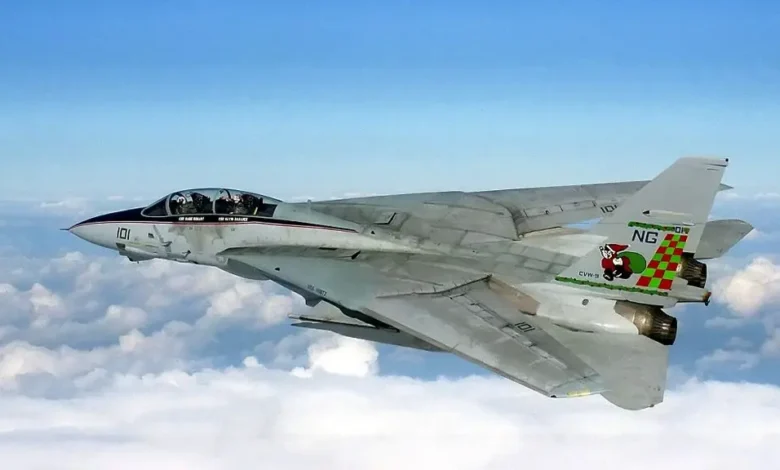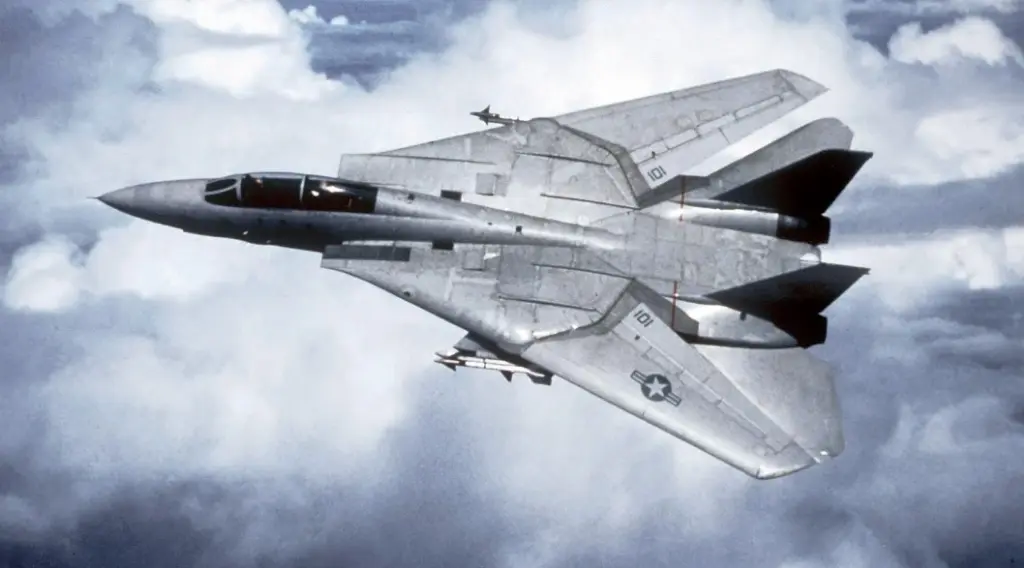F-14 Tomcat

The F-14 Tomcat is a twin-engine, variable-sweep wing fighter aircraft developed by Grumman for the U.S. Navy. Introduced in 1974, the F-14 was designed as a long-range air superiority fighter and fleet defense interceptor. Known for its distinctive swing-wing design and advanced avionics, the Tomcat became an iconic aircraft, famously featured in the movie “Top Gun.”
Fact Sheet
| Role | Air superiority and fleet defense interceptor |
|---|---|
| Manufacturer | Grumman |
| First Flight | 1970 |
| Service Entry | 1974 |
| Crew | 2 (pilot and radar intercept officer) |
Specifications
| Length | 19.1 m (62 ft 9 in) |
|---|---|
| Wingspan | 19.55 m (64 ft 1 in) extended, 11.65 m (38 ft 2 in) swept |
| Height | 4.88 m (16 ft) |
| Empty Weight | 19,838 kg (43,735 lb) |
| Max Takeoff Weight | 33,724 kg (74,350 lb) |
| Powerplant | 2 × Pratt & Whitney TF30-P-414A turbofans |
| Thrust | 20,900 lbf (93 kN) per engine with afterburner |
| Max Speed | Mach 2.34 (2,485 km/h; 1,544 mph) |
| Service Ceiling | 16,000 m (52,000 ft) |
| Range | 1,600 mi (2,575 km) combat radius |
| Rate of Climb | ~45,000 ft/min (229 m/s) |
Avionics & Armament
| Main Radar | AN/AWG-9 radar |
|---|---|
| Avionics | Advanced radar and targeting systems |
| Armament | One 20-mm M61A1 rotary cannon (675 rounds); Up to 6 external hardpoints for: – Air-to-air missiles (AIM-54 Phoenix, AIM-7 Sparrow, AIM-9 Sidewinder) – Bombs (precision-guided or conventional) – External fuel tanks |
Notable Features
- Variable-sweep wings for optimized performance at different speeds.
- Long-range radar for fleet defense and interception.
- Iconic design featured in popular culture.
- Proven combat record in multiple conflicts.
- Retired from U.S. Navy service in 2006, but still operated by Iran.

When you think of a truly iconic fighter jet, chances are the Grumman F-14 Tomcat comes to mind. Immortalized in films and revered by aviation enthusiasts, this powerful aircraft was the quintessential symbol of U.S. Navy air power for over three decades. With its distinctive variable-sweep wings and a design built for sheer dominance, the F-14 was a magnificent beast, designed to protect aircraft carrier battle groups against overwhelming threats.
Let’s soar into the history and incredible capabilities of the F-14 Tomcat, the undisputed king of the skies for a generation of naval aviators.
A Cold War Necessity: The Tomcat’s Birth
The F-14’s story begins in the turbulent late 1960s. The U.S. Navy was looking for a new fleet defense interceptor to counter the growing threat of Soviet long-range bombers and cruise missiles that could target its precious aircraft carriers. After the problematic F-111B program (a joint Air Force/Navy project) was cancelled, Grumman, a legendary naval aircraft manufacturer, was tasked with creating a dedicated carrier-capable fighter.
The result was the F-14 Tomcat, which first flew on December 21, 1970. It officially entered service with the U.S. Navy in 1974, replacing the F-4 Phantom II and quickly establishing itself as a formidable deterrent during the tense years of the Cold War.
The Defining Feature: Variable-Sweep Wings
The F-14’s most recognizable and technologically advanced feature was its variable-sweep wing design, often called “swing wings.” This innovative system allowed the aircraft to optimize its wing shape for different flight conditions:
- Swept Forward (20 degrees): For slower speeds, like takeoff and landing on an aircraft carrier, the wings would be extended forward. This provided maximum lift and improved stability at low airspeeds, crucial for safe carrier operations.
- Swept Back (up to 68 degrees): For supersonic flight and high-speed interception, the wings would sweep back, reducing drag and allowing the F-14 to achieve speeds exceeding Mach 2.34 (over 2,400 km/h or 1,500 mph).
- Automatic Control: A sophisticated computer system (the Central Air Data Computer) could automatically adjust the wing sweep throughout the flight, ensuring optimal performance without constant pilot intervention. This unique feature gave the F-14 an unmatched blend of low-speed agility and high-speed dash capability.
The Long Arm of the Fleet: Radar and Weapon Systems
The F-14 wasn’t just fast and agile; it was designed to be a long-range powerhouse, especially for engaging multiple threats at once:
- AN/AWG-9 Radar: This powerful X-band radar system, developed by Hughes, was revolutionary for its time. It could track up to 24 targets simultaneously and engage six targets at once with its long-range missiles at distances of up to 100 miles (160 km). This “multiple-target engagement” capability was critical for defending carrier battle groups against waves of incoming Soviet bombers and missiles.
- AIM-54 Phoenix Missile: The F-14 was built around the AIM-54 Phoenix, the first operational long-range radar-guided air-to-air missile. With its own onboard radar, the Phoenix could be launched from over 100 miles away, guiding itself to a target, making the F-14 a true “outer air battle” interceptor.
- Complementary Missiles: In addition to the Phoenix, the F-14 carried AIM-7 Sparrow medium-range radar-guided missiles and AIM-9 Sidewinder short-range infrared-guided missiles for closer-in engagements.
- Internal Cannon: For the ultimate close-quarters combat, it also featured a powerful 20mm M61 Vulcan Gatling gun with 675 rounds.
Two-Person Team: Pilot and RIO
The F-14 featured a two-person crew: the pilot in the front cockpit and the Radar Intercept Officer (RIO) in the back. This division of labor was essential. The RIO was a highly skilled operator, managing the complex AWG-9 radar, weapons systems, and electronic warfare countermeasures, allowing the pilot to focus solely on flying the aircraft and maneuvering in combat. This team approach was crucial for maximizing the Tomcat’s formidable capabilities.
Evolution and Adaptation: From Interceptor to Bomber
While initially a pure air superiority interceptor, the F-14’s robust design allowed for significant upgrades and adaptation over its long service life:
- F-14A: The initial production variant, powered by Pratt & Whitney TF30 engines (which were notoriously temperamental, especially at high angles of attack).
- F-14B (originally F-14A+): Introduced more powerful and reliable General Electric F110-GE-400 turbofan engines. These vastly improved performance, acceleration, and reliability.
- F-14D Super Tomcat: The ultimate variant, featuring the GE F110 engines, advanced digital avionics, a new AN/APG-71 radar (an upgraded AWG-9), a new infrared search and track (IRST) system, and an improved glass cockpit.
- Ground Attack Capabilities (Bombcat): In the 1990s, with the end of the Cold War and shifting priorities, the F-14 was given a significant ground attack capability. Equipped with the LANTIRN (Low Altitude Navigation and Targeting Infrared for Night) pod, it could precisely deliver laser-guided bombs (like the Paveway series) and later GPS-guided Joint Direct Attack Munitions (JDAMs). This transformed the Tomcat into a versatile “Bombcat,” flying strike missions in addition to its air defense role. The ability to carry over 14,000 pounds of ordnance made it a powerful strike platform.
- Tactical Air Reconnaissance Pod System (TARPS): Many F-14s were also equipped with the TARPS pod, giving them the ability to conduct vital aerial reconnaissance missions, collecting photographic and electronic intelligence.
The Undefeated Legend: Combat Record
The F-14 Tomcat holds a legendary combat record, especially with its primary operator, the U.S. Navy, and its sole export customer, Iran:
- U.S. Navy: F-14s achieved five air-to-air kills with the U.S. Navy. Notably, two F-14s shot down two Libyan Su-22s in 1981 in the Gulf of Sidra, and two more shot down two Libyan MiG-23s in 1989 in the same area. In 1991, an F-14 scored its only kill in Operation Desert Storm, shooting down an Iraqi Mi-8 helicopter.
- Iranian Air Force: Iran received 79 F-14As before the 1979 revolution. During the Iran-Iraq War (1980-1988), Iranian F-14s saw extensive combat, claiming a remarkable number of air-to-air victories against Iraqi aircraft. While exact numbers are debated due to wartime secrecy and propaganda, unofficial estimates suggest over 150 kills with the F-14, making it arguably the most successful fighter of that conflict. The mere presence of an Iranian F-14 often caused Iraqi aircraft to break off attacks and flee. Iran still reportedly operates a small number of F-14s today, a testament to its design’s durability and Iranian ingenuity in maintaining them despite sanctions.
Retirement and Enduring Legacy
The U.S. Navy officially retired the F-14 Tomcat on September 22, 2006, bringing an end to an era of “Top Gun” fame and unparalleled aerial prowess. The primary reasons for its retirement were high operating and maintenance costs, as well as the Navy’s strategic decision to transition to the more multi-role and arguably more cost-effective F/A-18E/F Super Hornet and later the F-35 Lightning II.
Despite its retirement, the F-14 Tomcat remains an icon. Its dramatic swing-wing design, its powerful long-range capabilities, and its extraordinary combat record have secured its place as one of the most beloved and respected fighter jets in aviation history. The “Cat” may no longer patrol the skies for the U.S. Navy, but its legend continues to inspire awe and fascination.



